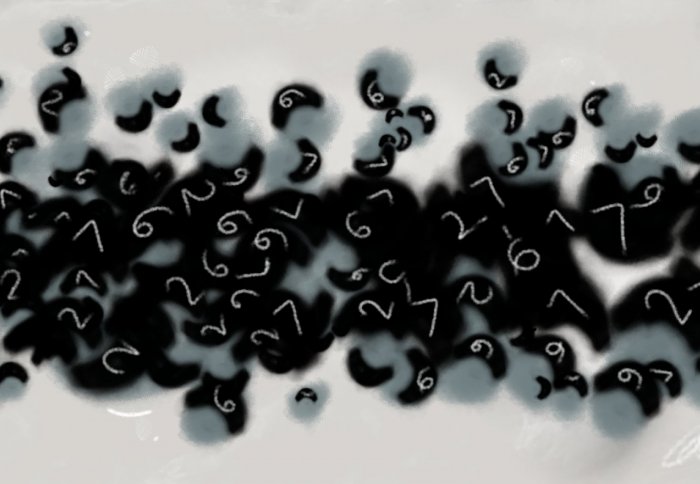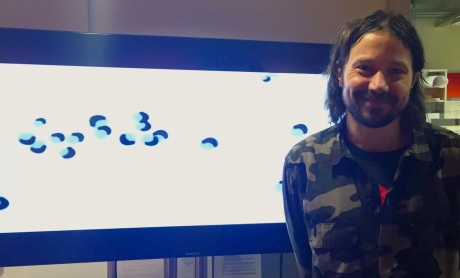Science in motion: Dr Serge Mostowy discusses animating his research

A still from 'Loop'. Image credit - Silent Signal / Samantha Moore.
Dr Serge Mostowy is a Research Fellow in the Department of Medicine. At this year’s Imperial Festival, he discussed how his research into septin assembly became the focus of a short animated feature, Loop. The film was produced in partnership with the award-winning animator Samantha Moore, and was produced by Animate Projects with support from the Wellcome Trust.
How did this collaboration with Samantha Moore come about?
I’m a Wellcome Trust-funded scientist. They put out a call for an Arts Award; Animate Projects wanted to team up artists and scientists. I went to a speed-dating type of event, organised by Animate Projects, and I was paired with Samantha Moore, which was a blessing – she’s fantastic. Eventually, due to those initial interactions, there was enough data to get a Large Arts Award from the [Wellcome] Trust, and then we had a year together to produce an animation representing my science. This was to not only push my science forward, but to explain what my science was doing to a more general audience.
What has the public response been so far?
The response from both the public and the Wellcome Trust has been really great. [Loop] has been on display at various festivals and galleries. Every time it’s presented at a venue, we usually have a Q&A where different artists and scientists will speak respectively about their works. The film is actually a part of a set with five other collaborations. The best part was probably the response from my lab; it was really great to have this project to inspire us all. It was a fantastic experience – I’d do it again in a second.
People are very quick to make distinctions between art and science. What do you think the problems are with that dichotomy?
I have to admit that I was hesitant before I started all of this, because there is a huge void between the two. But I think that there has to be a more important push to explain the “in-depthness” of science to a more general audience, in order for our work to be better understood and to make a greater impact. Animation is a fantastic way to do that.
We’re a microscopy lab, we’re very heavily involved in cell biology and we’re very visual. Working with Samantha to create an animation forced us to put our science into really simple terms, and to explain how we visualise it. As a result, it really helped us to understand what we know, and what we didn’t know. It was great because it generated novel hypotheses for us to look for under the microscope, and to subsequently test.
Given that you already had strong ideas about the visual aspects of your science, how much creative control did you have when you were working with Samantha?
I was really lucky because she took an interest in our work. She read all of the papers, and she really got into the details. As a cytoskeleton lab, there are certain fundamental aspects that aren’t so exciting, but she really took an interest in how the cytoskeleton components assemble, and it’s quite intricate. I was the scientific advisor on the work, but she had full creative control. I think what was really special was that she talked to each member of my lab individually, without me around. By doing this, she got an insight into how the different postdocs and students in our group saw not only their respective projects, but where the direction of the science was going as a whole. She would ask for their input at the end of it all; it was an iterative process. It took a year to put together a 5-minute animation.
Do you think then that the film doesn’t just reflect your research, but also the different personalities within your team and your working environment?
It definitely captures the diversity of the group, and also the diversity of the science, and how we work together to solve common questions. It really highlights how everyone sees it a little bit differently.
Would you say that public engagement is becoming an increasingly more important part of grantsmanship and funding applications?
I’m seeing it more and more in applications, and working on this project has been really great in that respect. It’s increasingly important to articulate your science to the public. It’s about more than just getting funding; it’s about having greater impact. You really can make a difference if more people understand it.

Dr Serge Mostowy at this year's Imperial Festival
It’s a completely different platform to discuss your findings, rather than in a journal, for instance.
Yes, when you engage with the public, you have to keep their attention; you have to explain why it’s important. Sometimes you get lost in the details in science, and you have to remember that there are greater causes. Public engagement forces us to maximise our impact. With Loop, you can just press play to explain to people very quickly about what it is that we do. You get an instant feel for some of the major questions that we’re tackling, and where we’re going with our science.
I think it is important to hide behind a microscope as a scientist, but there does have to be a platform available for us to explain our work, so that it’s appreciated and to achieve greater impact.
Do you think there’s a risk of trivialising your science by translating this kind of subject matter into animation?
When I first started saying that I was going to do this project, some people just didn’t get it. You don’t want to trivialise your science, or become a “pop scientist”. You don’t want to risk your reputation. But this is funded by the Wellcome Trust – what greater incentive do you need?
There is a huge sense of pride that comes from an artist depicting your work; it’s been great for our lab. I can share it with my parents, they can share it with their friends; it’s had a major impact, more than I ever predicted. I have absolutely no regrets about this. I was concerned at the beginning about the amount of time it would take up, but it was a minimal amount of time, and I have to give full credit to Samantha for really pushing it. She came to us, she visited the lab, and that was really great for us. It’s still a very serious animation, it still reflects the questions that we are currently asking. It helped to push and innovate some ideas, and it forced my team to think in ways they normally would not. What more could you ask for as a research group?
You can watch Loop on Vimeo, and find out more about the project on the Silent Signal website.
Article supporters
Article text (excluding photos or graphics) © Imperial College London.
Photos and graphics subject to third party copyright used with permission or © Imperial College London.
Reporter
Ms Genevieve Timmins
Academic Services